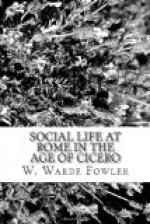Sun-dials, once introduced with the proper reckoning for latitude, soon came into general use, and a considerable number still survive which have been found in Rome. In a fragment of a comedy by an unknown author, ascribed to the last century B.C., Rome is described as “full of sun-dials,"[413] and many have been discovered in other Roman towns, including several at Pompeii. But for the ordinary Roman, who possessed no sun-dial or was not within reach of one, the day fell into four convenient divisions, as with us it falls into three,—morning, afternoon, and evening. As they rose much earlier than we do, the hours up to noon were divided into two parts: (1) mane, or morning, which lasted from sunrise to the beginning of the third hour, and (2) ad meridiem, or forenoon; then followed de meridie, i.e. afternoon, and suprema, from about the ninth or tenth hour till sunset. The authority for these handy divisions is Censorinus, De die natali (23. 9, 24. 3). There seems to be no doubt that they originated in the management of civil business, and especially in that of the praetor’s court, which normally began at the third hour, i.e. the beginning of ad meridiem, and went on till the suprema (tempestas diei), which originally meant sunset, but by a lex Plaetoria was extended to include the hour or two before dark.
The first thing to note in studying the daily life at Rome is that the Romans, like the Greeks, were busy much earlier in the morning than we are. In part this was the result of their comfortable southern climate, where the nights are never so long as with us, and where the early mornings are not so chilly and damp in summer or so cold in winter. But it was probably still more the effect of the very imperfect lighting of houses, which made it difficult to carry on work, especially reading and writing, after dark, and suggested early retirement to bed and early rising in the morning. The streets, we must remember, were not lighted except on great occasions, and it was not till late in Roman history that public places and entertainments could be frequented after dark. In early times the oil-lamp with a wick was unknown, and private houses were lighted by torches and rude candles of wax or tallow.[414] The introduction of the use of olive oil, which was first imported from Greece and the East and then produced in Italy, brought with it the manufacture of lamps of various kinds, great and small; and as the cultivation of the valuable tree, so easily grown in Italy, increased in the last century B.C.,[415] the oil-lamp became universal in houses, baths, etc. Even in the small old baths of Pompeii there were found about a thousand lamps, obviously used for illumination after dark.[416] But in spite of this and of the invention of candelabra for extending the use of candles, it was never possible for the Roman to turn night into day as we do in our modern town-life. We must look on the lighting of the streets as quite an exceptional event. This happened, for example, on the night of the famous fifth of December 63 B.C., when Cicero returned to his house after the execution of the conspirators; people placed lamps and torches at their doors, and women showed lights from the roofs of the houses.




